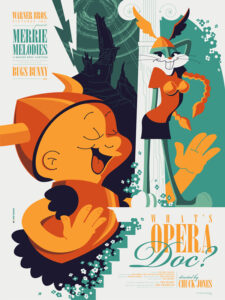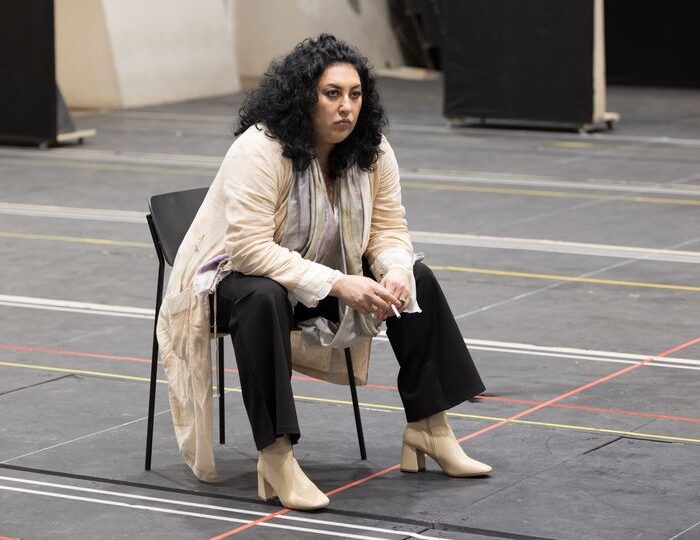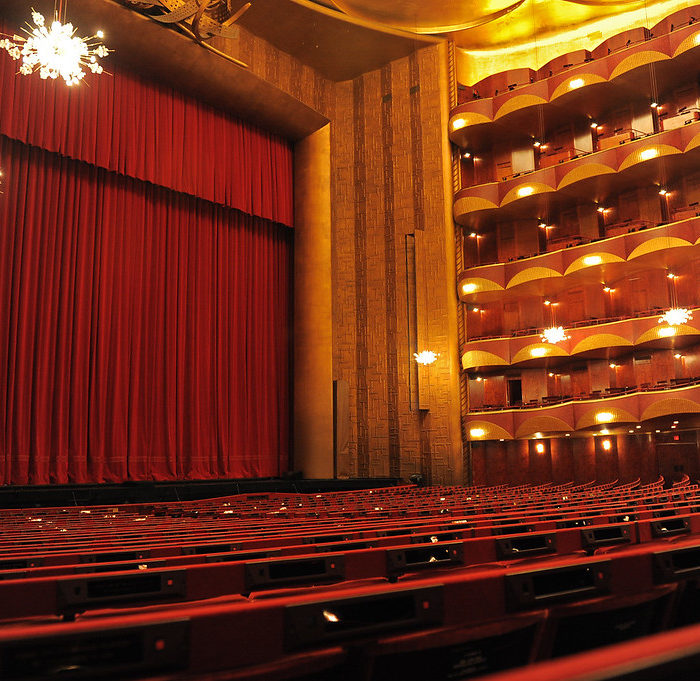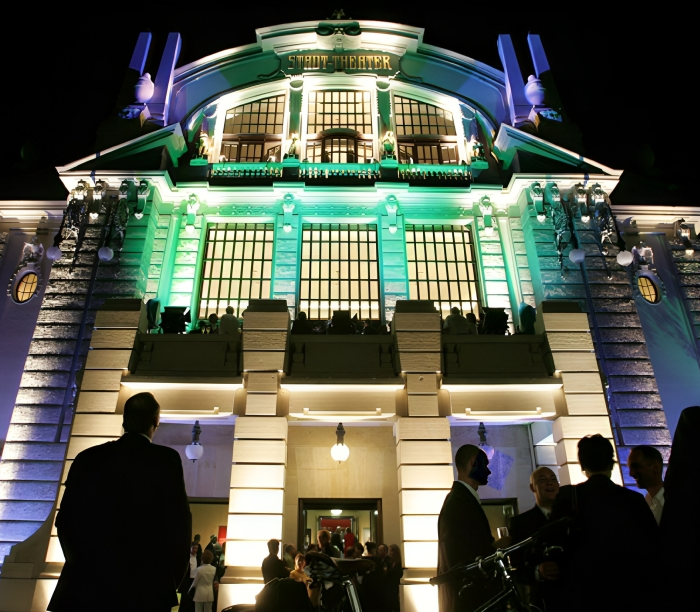
Opera Meets Film: A Little Bit of Satire & Wagner in ‘What’s Opera, Doc?’
By John VandevertWhat do you get when you cross Richard Wagner’s “The Ring Cycle,” with its dramatic story of warring gods and goddesses told by the light of an exorbitant musical tapestry, the humorous animations of Warner Bros., a large helping of ironic self-awareness? Well, you end up with “What’s Opera, Doc?”
The brain child of animators Chuck Jones and Michael Maltese, the film featured the famous animated characters Bugs Bunny and Elmer Fudd reenacting exaggerated elements of Wagner’s four-opera epic, ending up in odd positions while accompanied by the sounds of opera and orchestral showmanship. Featuring the music of five of Wagner’s operas and Night on Bald Mountain by Modest Mussorgsky, the film was a success with audiences all across America, and was quickly seen as one of the most important pieces of animated film in the history of the artform. The film also served as the impetus for many musicians to get into opera itself. In this Opera Meets Film, we’ll be specifically looking at the film’s music in order to understand the makeup of the film’s musical score.
Which operas were used in the film? Where did they come from exactly? What the heck is Rienzi?!
The Film’s Wagnerian Decadence
The animated film uses a selection of operatic excerpts from Richard Wagner’s large list of completed operas, of which there are 13 with five never being finished. Despite being modeled after his most famous creation, The Ring of Nibelung (Der Ring des Nibelungen), Jones’ comic film uses both early, middle, and late-Wagnerian selections. From the titan’s “early” phase (1832-1842), the overture to Wagner’s opera “Rienzi” was taken. The first opera to be successfully staged, “Rienzi” was a continuation of the mid-19th century style of the luxurious, historically rooted, “grand opera” tradition. Made popular, in no small way, by the neo-Italianate works of Giacomo Meyerbeer, Daniel Auber, and Guiseppe Verdi, the rather costly, bel canto-saturated, and highly packed world of grand opera came and went as desires for realism and easily understandable beauty eventually led to the birth of verismo, lyric opera, and eventually the Impressionists of the early-20th century. Think Claude Debussy’s gaseous work Pelléas et Mélisande, an opera which seems to go nowhere dramatically speaking and instead lives in the ambiguity of the unstated, something completely antithetical to Wagner. To use “Rienzi” is a fascinating choice on Jones’ part, as other operas as other early works like Das Liebesverbot have an thematic connection to The Ring Cycle, unlike the former, depicting the extremes of human eroticism and self-control.
But Jones’ reference to Wagner’s other works doesn’t just end at his early period. Rather, it extends into what is called Wagner’s “middle years.” In other words, 1843-1851 when the composer was beginning his journey into the world of Romanticism, an aesthetic movement built around exaggerated emotionality, nationalist appeals, a commune with the natural world, and greater focus on virtuosity, musicality, and compositional indulgence on nearly every front. From this period, Wagner’s operas “Der Fliegende Holländer” (1843) and Tannhäuser (1845) were sourced. The former was an embellished homage to Heinrich Heine’s famous 1833 novel, The Memoirs of Mister von Schnabelewopski, although it was also shaped by a harrowing voyage to Paris for the premiere of Rienzi in 1839 with first wife Minna Planer. The latter is among Wagner’s best operatic works outside his Ring Cycle, and is one of the hallmark pieces which defines the genre of German Romanticism. Based on a vast network of mythological stories, epic narratives, and folklore from the German past, the three-act opera weaves together the fictional life of Tannhäuser the Minnesänger (Minstrel Singer) and the Wartburg Sängerkrieg (Song festival), a supposedly real event held in 1207. It’s known that the opera’s overture was greatly admired by Queen Victoria in 1855 during a concert at the Philharmonic Society of London while living in London.
As stated, the Ring Cycle was the film’s primary focus of the film musically, only two operas of the cycle’s four epics were referenced. Namely, the second (Die Walküre) and the third (Siegfried). Having become defeated by the fate undergone by his “Rienzi” and “Tannhäuser,” Wagner’s decisions as a composer were forever changed. No longer just content with opera, he desired to make “dramas.” A cohesive synthesis of music, text, and dramaturgy, Wagner’s idea of a three-day event as codified in a set of extended essays written from 1849-1851, the mighty Ring Cycle was formed. Because Romanticism is inseparable from nationalism, Wagner’s work took a decidedly nationalist orientation, and thus the Ring Cycle’s story was a dramatized, allegorical, and moralistic “national epic” which takes a critical stance on the desires of man, among other interpretations. Modeled particularity after the Nibelungenlied (The Song of the Nibelungs), a decidedly nationalist tale of the ostensible tenacity of the German spirit, the opera showcases the grim fall of Gods and Goddesses as they battle and war against each other for ownership of the golden ring. “Die Walküre,” the second of the four operas to be written, is best known for its Act 3 overture, while Siegfried, finished not until 1869, charts the story of Wotan’s son who, through many brave actions, manages to free the entrapped Brünnhilde and is justly rewarded.
A Little Bit of Mussorgsky on the Side
However, the film uses a non-Wagnerian piece of music as well. Namely, one of Modest Mussorgsky’s most well known and beloved pieces of symphonic literature, “Night on Bald Mountain” (Nochna lysoy gore).
Known for his role in the compositional group known as the “Mighty Five,” Mussorgsky was a champion of creating a truly ‘Russian’ musical language which did not depend on German influence as others like composer Anton Rubenstein’s style reflected. Based on the Slavic folk story of the ‘Witches Sabbath,’ a gathering of witches during Kupala Night (or St. John’s Day), the work underwent nearly 100+ years of revisions, its construction beginning in 1839 and coming to a somewhat halted place in 1940 thanks to British conductor Leopold Stokowski and his stylized orchestration based on “Mighty Five” member and critic Nikolai Rimsky-Korsakov’s 1886 arrangement.
Although never performed during Mussorgsky’s life, the work has been pushed into the popular consciousness thanks, primarily, to Disney and its 1940 film Fantasia. Stokowski’s version was especially composed for the occasion, trying his best to remain close to Mussorgsky’s original vision due to his knowledge of his style. That is to say a musical style which is emotional, orchestrally adept, acutely aware of harmonic and melodic modernism vs. traditionalism, incorporations of exoticism and foreign soundscapes, and a unique sensitivity towards blending folk idioms with classical constants. Overall, a synthesis of high and low without foreign dependance.
Opera by Popular Exposure
Much has already been said about the important role television and wider popular media plays in the expanding of the classical music audience. Many, like myself, got their start in classical music because of popular media’s impact upon them. I remember listening to Fantasia and Baby Mozart as a child, being inspired by the tunes and fantastic images of Disney. Captivated by what classical music was, I wanted to learn as much as I could.
However, Jones’ film is particularly noteworthy because of its impact upon the eventual careers of several well-known operatic and classical music performers and participants. Chief among them being the mezzo-soprano Elizabeth Bishop, best known for her extravagantly sung dramatic roles like Salome and Fricka. Reminiscing to writer Michael Phillips Bishop noted that the tunes of Wagner were imprinted into her mind well before she could ascertain the composer and the music’s actual origins. As she notes, “I could sing you the entire cartoon before I knew what opera really was.” Another equally seminal voice in operatic theater is Jamie Barton, known for her deep tone and stable musicality. In conversation with Phillips, she noted that the animated film was the first time she was ever formally exposed to Wagner’s music.
But one more case also exists, that being Michael Heaston, former pianist of Dallas Opera, who noted that Jones’ film was the reason why he chose to pursue a career in operas opposed to other art forms. Lest you think that the film’s impact was only a minor one, upon the film’s 50th anniversary (2007), many reassessed the film’s appreciable influence upon the fabric of American society itself. So important was the film that 15 years earlier (1992), the Library of Congress added the film to the National Film Registry, while in 1994 the film was included among the 50 greatest cartoons in history.
Thanks to Jones and Maltese, generations of opera lovers young and old can be and were exposed to the marvelous music of Wagner. Thanks to the internet, the film will live on and be the catalyst for many more to come.


